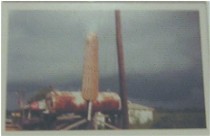
I still remember my brownie camera. It was the beginning of my career as the world’s worst photographer. Or at least that’s what my father had me believing.
After he gave it to me and showed me how to load it, I began snapping away. Boy, was he irked.
Photography was his hobby, and he had a darkroom and the works. But he was the kind of guy who patiently set up his shots and never took more than was needed. In those days before color (yes I’m that old), he took beautiful black and white portraits of everyone in the family, photos that my cousins still cherish. Sometimes he hand tinted them.
So my quick snaps were not what he was expecting. And both of us were disappointed with the results.
To this day, I tell people I’m the world’s worst photographer. And I’m filled with admiration when someone can get a beautiful product out of a Brownie camera.
All of this is my roundabout way of getting to the “Mavericks of Color” show at the Philadelphia Museum of Art’s Julien Levy Gallery, aka the Julien Levy corridor. The point of the show is that color photography didn’t gain immediate acceptance in a black-and-white world.
Curated by Katherine Ware, the PMA’s curator of photographs, the exhibit displays work, some of it familiar, some not, that helped push the transition of art photography from black and white to color and to vernacular themes–signs, colored lights and Southern-gothic portraits. In addition to a number of prints each from Willaim Eggleston, Joel Meyerowitz, William Christenberry and Elliott Porter, the show includes single examples from the 1970s by several other color pioneers.
What seemed most salient to me were the focus on signs and how they exerted visual power or failed to do so, depending on the environment.
This is where I revert to the Brownie camera story. A bunch of the William Christenberry photos were made with a Brownie. I’m filled with admiration. They are small, square beauties of faded store fronts down old Southern Main Streets, not to be mistaken for snapshots at all. Christenberry also took rectangular photos by other means. I loved his signs in the middle of nowhere. His eye for color and shape captures beauty in the godforsaken backwaters where development has gone to seed and prosperity seems elusive (“Corn Sign with Storm Cloud near Greensboro, Alabama,” 1977, chromogenic print).
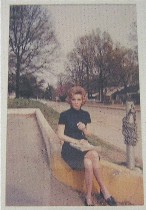 William Eggleston, another photographer of the South at its most gothic, took portraits that bring to mind more recent work by Alec Soth. But Eggleston’s people are metaphoric. His prim woman sitting next to a chain-entwined bollard, the old guy sitting on a bed holding his gyn, a portrait of a bicycle, and a portrait of a coat, its shape like a Klan hood, hanging on a hook, call out metaphor loud and clear (“Memphis,” 1969-70, dye transfer).
William Eggleston, another photographer of the South at its most gothic, took portraits that bring to mind more recent work by Alec Soth. But Eggleston’s people are metaphoric. His prim woman sitting next to a chain-entwined bollard, the old guy sitting on a bed holding his gyn, a portrait of a bicycle, and a portrait of a coat, its shape like a Klan hood, hanging on a hook, call out metaphor loud and clear (“Memphis,” 1969-70, dye transfer).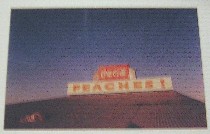
Eggleston’s sign portrait, “Untitled (Peaches!),” includes a Coca Cola ad with deco marquee wings on top of the down-to-earth peaches sign on top of a rock-strewn roof under a spectacular sky. It’s all rather cinematic and speaks to the power of advertising and commerce and the shift from rural to urban.
Both Eggleston and Christenberry use place names to entitle their images, a nod to photography as an archival process, recording the landscape of life for posterity.
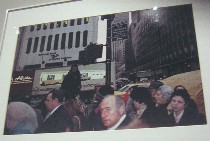 Joel Meyerowitz, who also lays claim to archiving with his place-name titles, gets a lot of play out of scale anomalies–the woman on a billboard on the side of a truck out of scale with the pedestrians in “New York City,” huge Coca Cola bottle ads towering over people, the Empire State Building looking delicate and not too tall compared to closer buildings (image, “New York City,” chromogenic print, 1975)
Joel Meyerowitz, who also lays claim to archiving with his place-name titles, gets a lot of play out of scale anomalies–the woman on a billboard on the side of a truck out of scale with the pedestrians in “New York City,” huge Coca Cola bottle ads towering over people, the Empire State Building looking delicate and not too tall compared to closer buildings (image, “New York City,” chromogenic print, 1975)

The early bird portraits of Elliott Porter, from 1941, look a lot like Audubon prints. But in the ’70s, Porter’s birds are in motion against the sky or foliage, and startle with the magical power of flight.
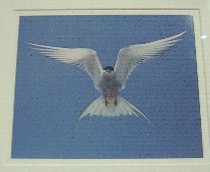
Porter’s early birds break ground in their use of color, which really doesn’t hatch as an art form for another two or three decades.
The single David Graham resurrects the Southern Gothic portrait formula in Pennsylvania, and the Lucas Samaras self-portrait polaroid is a reminder of his experimental approach with the material. The show also included single photos by Harry Callahan, Stephen Shore and William Larson .
christenberry, william
ware, katherine
meyerowitz, joel
porter, elliott
eggleston, william
graham, david









